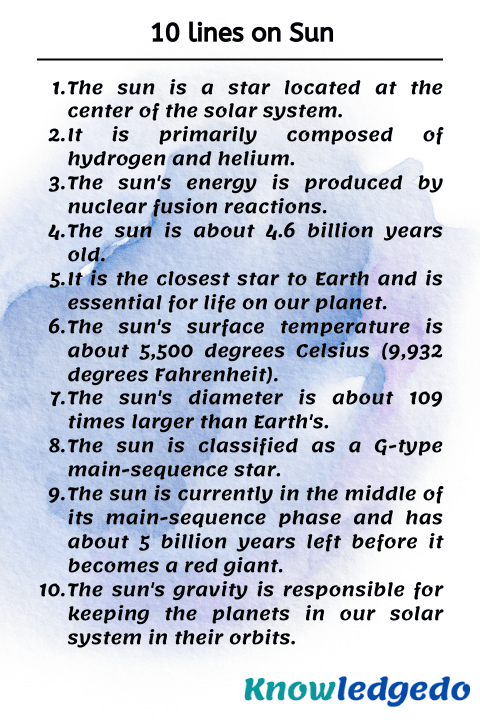Today, we are sharing 10 lines on Sun in English This article can help students who are looking for information about 10 lines on Sun. This essay is very simple and easy to remember. The level of this essay is moderate so any student can write on this topic.
This article is generally useful for class 1,class 2,class 3,class 4,class 5,class 6,class 7,class 8,class 9,class 10,class 11,class 12
10 lines on Sun
1) The sun is a star located at the centre of the solar system.
2) It is primarily composed of hydrogen and helium.
3) The sun’s energy is produced by nuclear fusion reactions.
4) The sun is about 4.6 billion years old.
5) It is the closest star to Earth and is essential for life on our planet.
6) The sun’s surface temperature is about 5,500 degrees Celsius (9,932 degrees Fahrenheit).
7) The sun’s diameter is about 109 times larger than Earth’s.
8) The sun is classified as a G-type main-sequence star.
9) The sun is currently in the middle of its main-sequence phase and has about 5 billion years left before it becomes a red giant.
10) The sun’s gravity is responsible for keeping the planets in our solar system in their orbits.

5 lines on Sun
1) The sun is a star located at the centre of the solar system.
2) It is primarily composed of hydrogen and helium.
3) The sun’s energy is produced by nuclear fusion reactions.
4) The sun is essential for life on Earth as it provides light and warmth.
5) The sun’s gravity is responsible for keeping the planets in our solar system in their orbits.
FAQ
Answer: The sun is primarily composed of hydrogen and helium, with small amounts of other elements such as oxygen, carbon, and neon.
Answer: The sun produces energy through nuclear fusion reactions, where hydrogen atoms are combined to form helium, releasing a tremendous amount of energy in the process.
Answer: The sun provides light and warmth to Earth, and its gravity keeps the planet and other bodies in the solar system in their orbits. The sun’s energy also drives weather patterns and supports all life on Earth through photosynthesis.
Answer: The sun is currently in the middle of its main-sequence phase and has about 5 billion years left before it becomes a red giant and eventually exhausts its fuel and dies.
